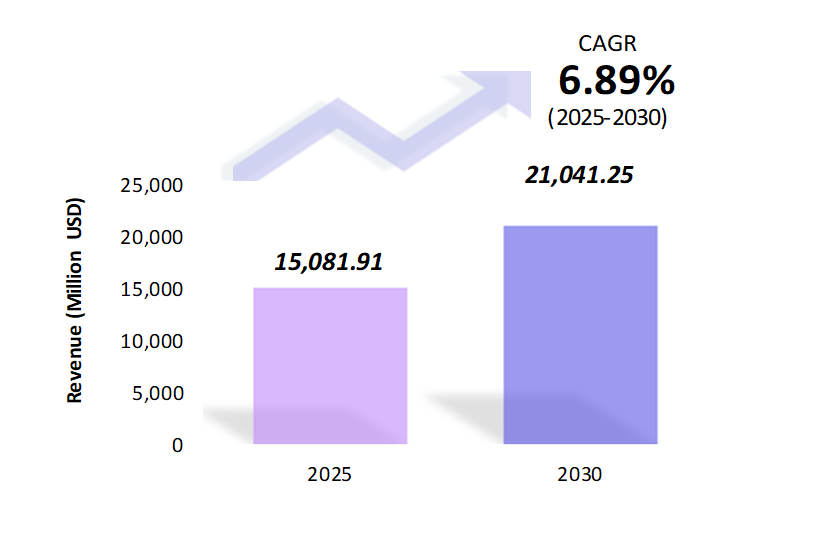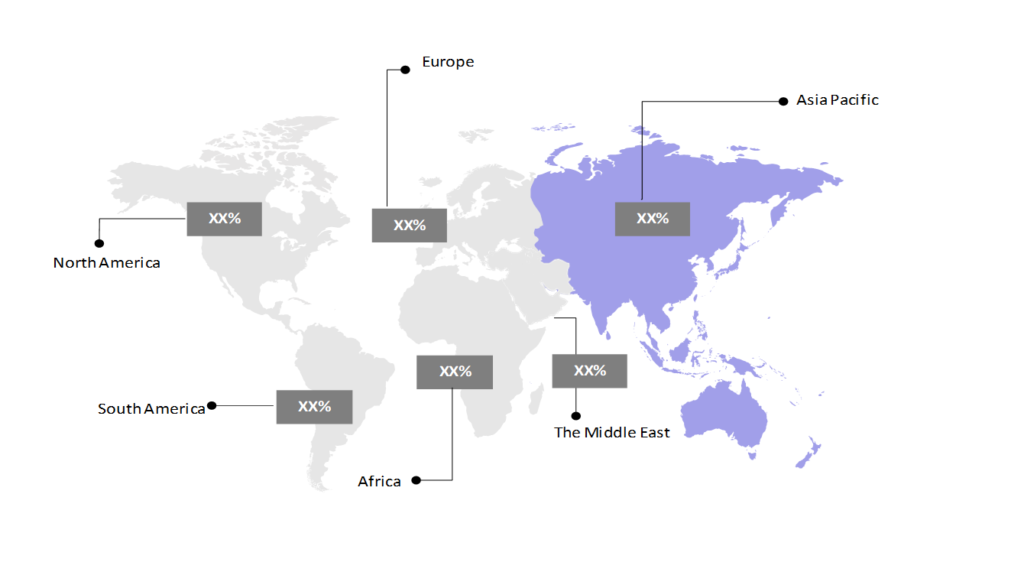Basmati Rice Market: Size, Share, Trends & Forecast (2024-2029)
The market report offers a detailed analysis segmented by Species (White, Brown, Others); by Application (Industrial, Household); by Geography (North America, South America, Asia Pacific, Europe, The Middle East, Africa).
Outlook

- The basmati rice market is estimated to be at USD 15,081.91 Mn in 2025 and is anticipated to reach USD 21,041.25 Mn in 2030.
- The basmati rice market is registering a CAGR of 6.89% during the forecast period 2025-2030.
- The basmati rice market is driven by increasing global demand for premium rice varieties. Rising consumer interest in ethnic cuisines and health-conscious eating habits further boosts its appeal. However, the market faces challenges related to climate change, trade restrictions, and competition from lower-cost rice varieties. Innovations in sustainable farming, processing, and packaging are key to maintaining competitiveness.
Request a free sample.
Ecosystem

- The participants in the global basmati rice industry are always developing their strategies to preserve a competitive advantage.
- Smaller producers and exporters focus on niche markets and local customer bases, often competing on price or specialized product offerings. Competition is also influenced by factors like product quality, sustainability practices, and compliance with international regulations.
- Several important entities in the basmati rice market include East End Foods; Kohinoor Foods Ltd.; Mars, Inc.; KRBL Ltd.; Estraco Ltd.; and others.
Ask for customization.
Findings
| Attributes | Values |
|---|---|
| Historical Period | 2019-2023 |
| Base Year | 2024 |
| Forecast Period | 2025-2030 |
| Market Size (2025) | USD 15,081.91 Mn |
| Market Size (2030) | USD 21,041.25 Mn |
| Growth Rate | 6.89% CAGR from 2025 to 2030 |
| Key Segments | Species (White, Brown, Others); Application (Industrial, Household); Geography (North America, South America, Asia Pacific, Europe, The Middle East, Africa) |
| Key Vendors | East End Foods; Kohinoor Foods Ltd.; Mars, Inc.; KRBL Ltd.; Estraco Ltd. |
| Key Countries | The US; Canada; Mexico; Brazil; Argentina; Colombia; China; India; Indonesia; The UK; Germany; Italy; UAE; Saudi Arabia; Iran; Kenya; South Africa |
| Largest Market | Asia Pacific |
Get a free quote.
Trends
- Sustainable Farming Techniques: The Alternate Wet Drying (AWD) method involves intermittent flooding and drying of rice paddies, which reduces water and energy consumption and cuts greenhouse gas emissions. The Tilda company is collaborating with farmers in India to implement AWD, which promotes sustainable rice cultivation.
- Eco-Friendly Packaging: In response to growing environmental concerns, retailers are adopting recyclable, paper-based packaging for rice and grains. This initiative covers more than 30 products, including basmati rice, which are now offered in eco-friendly paper bags or boxes. This shift is part of a broader effort to reduce plastic use and promote sustainability in line with environmental goals.
- Processing and Quality Enhancement: Innovative milling technologies are being introduced in the Basmati rice industry to improve the efficiency of processing while enhancing the quality of the final product. These advancements focus on optimizing the removal of husk and bran layers, which leads to better texture and appearance of rice grains. The use of precision milling equipment allows for more consistent grain size and reduced breakage, which results in higher-grade Basmati rice that meets international standards.
Speak to analyst.
Catalysts
- Increasing Consumer Preference for Premium Rice Varieties: Basmati rice is recognized globally for its unique fragrance, long grains, and delicate flavor, which makes it a preferred choice among consumers seeking high-quality rice. This preference is particularly noticeable in regions like North America and Europe, where there has been a growing shift towards premium, aromatic rice.
- Rising Demand for Ethnic and Specialty Foods: The globalization of food culture has significantly boosted the demand for traditional ethnic dishes, particularly Indian, Middle Eastern, and Persian cuisines, where basmati rice is a staple ingredient. The expansion of restaurants specializing in these cuisines and the increasing availability of ethnic food products in supermarkets are key drivers. For instance, major supermarket chains like Tesco and Walmart have expanded their ethnic food sections, including a variety of basmati rice brands, to cater to the rising consumer interest in international flavors and recipes.
- Export Policy Changes and Global Trade: Government initiatives and policy changes are driving global exports of basmati rice, particularly from India and Pakistan, the largest producers of Basmati. Recently, the Indian government removed the minimum export price for basmati rice, which made it more competitively priced in international markets. This move is expected to boost exports, with countries in the Middle East, Europe, and North America benefiting from easier access to affordable basmati rice. For example, India’s export volume to countries like Iran and Saudi Arabia has increased following the policy shift, further strengthening the country’s position as the leading exporter of basmati rice.
Inquire before buying.
Restraints
- Climate Change and Water Scarcity: Basmati rice cultivation is highly dependent on water-intensive farming methods, particularly in regions like India and Pakistan. The increasing frequency of droughts and irregular monsoon seasons due to climate change has led to water shortages, making rice farming more challenging.
- Price Volatility and Trade Restrictions: Fluctuating global rice prices and frequent changes in trade policies can create uncertainty for exporters and importers of basmati rice. For instance, sudden export restrictions imposed by the Indian government in 2023 due to concerns over domestic supply led to a temporary spike in international prices, affecting key importers like Saudi Arabia and the UAE. Such unpredictability in pricing and trade conditions makes it difficult for businesses to plan long-term strategies and can disrupt global supply chains.
- Pest Infestation and Quality Control Issues: Ensuring consistent quality in basmati rice is a major challenge due to the risk of pest infestations and improper storage. Issues such as the contamination of rice with mycotoxins and other harmful substances during storage and transportation can damage the reputation of Basmati rice brands and lead to regulatory bans. For example, the European Union has set strict standards on pesticide residues in imported rice, and any non-compliance can result in shipments being rejected or banned.
Personalize this research.
Hotspot

Explore purchase options.
Table of Contents
| 1. Introduction 1.1. Research Methodology 1.2. Scope of the Study 2. Market Overview / Executive Summary 2.1. Global Basmati Rice Market (2019 – 2023) 2.2. Global Basmati Rice Market (2024 – 2030) 3. Market Segmentation 3.1. Global Basmati Rice Market by Species 3.1.1. White 3.1.2. Brown 3.1.3. Others 3.2. Global Basmati Rice Market by Application 3.2.1. Industrial 3.2.2. Household 4. Regional Segmentation 4.1. North America 4.1.1. The US 4.1.2. Canada 4.1.3. Mexico 4.2. South America 4.2.1. Brazil 4.2.2. Argentina 4.2.3. Colombia 4.2.4. Rest of South America 4.3. Asia Pacific 4.3.1. China 4.3.2. India 4.3.3. Indonesia 4.3.4. Rest of Asia Pacific 4.4. Europe 4.4.1. The UK 4.4.2. Germany 4.4.3. Italy 4.4.4. Rest of Europe 4.5. The Middle East 4.5.1. Iran 4.5.2. UAE 4.5.3. Saudi Arabia 4.5.4. Rest of the Middle East 4.6. Africa 4.6.1. Kenya 4.6.2. South Africa 4.6.3. Rest of Africa 5. Value Chain Analysis of the Global Basmati Rice Market 6. Porter Five Forces Analysis 6.1. Threats of New Entrants 6.2. Threats of Substitutes 6.3. Bargaining Power of Buyers 6.4. Bargaining Power of Suppliers 6.5. Competition in the Industry 7. Trends, Drivers and Challenges Analysis 7.1. Market Trends 7.1.1. Market Trend 1 7.1.2. Market Trend 2 7.1.3. Market Trend 3 7.2. Market Drivers 7.2.1. Market Driver 1 7.2.2. Market Driver 2 7.2.3. Market Driver 3 7.3. Market Challenges 7.3.1. Market Challenge 1 7.3.2. Market Challenge 2 7.3.3. Market Challenge 3 8. Opportunities Analysis 8.1. Market Opportunity 1 8.2. Market Opportunity 2 8.3. Market Opportunity 3 9. Competitive Landscape 9.1. East End Foods 9.2. Kohinoor Foods Ltd. 9.3. Mars, Inc. 9.4. KRBL Ltd. 9.5. Estraco Ltd. 9.6. Company 6 9.7. Company 7 9.8. Company 8 9.9. Company 9 9.10. Company 10 |
Know the research methodology.
Basmati Rice Market – FAQs
1. What is the current size of the basmati rice market?
Ans. In 2025, the basmati rice market size is USD 15,081.91 Mn.
2. Who are the major vendors in the basmati rice market?
Ans. The major vendors in the basmati rice market are East End Foods; Kohinoor Foods Ltd.; Mars, Inc.; KRBL Ltd.; Estraco Ltd.
3. Which segments are covered under the basmati rice market segments analysis?
Ans. The basmati rice market report offers in-depth insights into Species, Application, and Geography.
